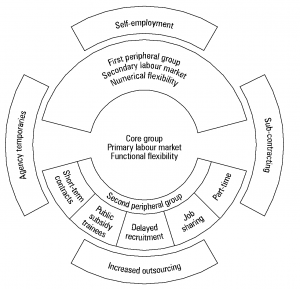
Psychology Dissertation Topics | 24 Trending Ideas in 2024
May 28, 2021
Executive Leadership and Governance
January 12, 2022Today’s globally integrated and technologically advanced world has created an environment where people can enjoy flexibility in their life. For instance, online banking has given people the flexibility to perform financial transactions any time they want which was previously possible only during banking hours. During the last decade, interconnectedness and mode of communication have increased immensely. By virtue of the internet, many UK businesses now have clients, customers and suppliers in other regions of the world such as the Middle East and China. As these regions have a time difference from that of the UK, therefore, to account for the time difference the UK businesses behave flexibly. In addition, due to increased flexible working practices like; flexitime, mobile working, increased emphasis on work-life balance and extended rights of employees regarding flexible working hours by the UK Government the firm flexibility has become a necessity (gov.uk, 30 June 2014).
In recent years due to dynamically changing global environmental factors such as technological advancement and social changes the emphasis on and utilization of flexible working patterns has increased. According to the CIPD report (2013), from the year 1997 to 2012 the number of employees working from home has increased to 3.5 million from 2.3 million. It was evident that part-time, temporary, or self-employed individuals comprise 2/5th of the total workforce population (CIPD, 2013).
According to an estimate for two-third of single parents, a job that has flexibility is considered an ideal job (ACAS, 2012). This evidence highlight that the importance and need for flexible workforce patterns. The flexibility of a firm can be defined as its ability to achieve business objectives by modifying the cost, size, arrangement, location, duration and activities of its workforce (Pilbeam & Corbridge, 2010). In this regards the Atkinson’s Flexible Firm Model (1984) and Handy’s Shamrock Organization model (1985) of firm flexibility are analyzed in this paper. Literature is evident that there are some pros and cons of using the firm flexibility model and so it is questionable if it is still effective or has become outdated and requires revision (CIPD, 2013; Beardwell, & Claydon, 2010; CIPD Staff, 2005; Dyer, 1998).
Therefore in this paper, the pros and cons of employing the flexibility model would be critically analyzed from the employer and employee point of view in the light of today’s environment to determine if it has become outdated and require revision or not.
Flexible Firm Model: Is it now Outdated and in Need of Revision?
The Flexible Firm Model (FFM) which was originally proposed by John Atkinson (1984) is a workplace management technique according to which enhanced flexibility is required by organisations to survive and stay competitive in dynamic business and market environment which could be achieved through workforce flexibility. Atkinson’s FFM proposes to design flexible workforce arrangements by segmenting the workforce into ‘Core’ (Primary) and ‘Peripheral’ (Secondary) employee groups as indicated in figure 1 (Atkinson, 1984). By segmenting the workforce into core and peripheral employee groups the organisation enables itself to achieve functional and numerical flexibility.

Figure 1 (Atkinson, 1984, p. 29)
Moreover, Handy’s Shamrock Organization model (1985) proposed a workforce arrangement in which employees are divided into three groups, namely; professional core, contractual fringe and flexible labour force as shown in figure 2. The professional core includes those employees on which the core competency of a business depends such as managers, technicians, and professional staff. They are permanent employees and their pay is related to the organisation’s performance. The contractual fringe is comprised of employees who are either self-employed or contractually hired and have technical and professional skills. While the flexible labour force is comprised of part-timers based on external demand. They are hourly paid, perform routine jobs and have no career track (Handy, 1985).

Figure 2 (Handy, 1985)
Based on Atkinson’s FFM (1984) and Handy’s Shamrock Organisation Concept (1985) five types of workforce flexibilities could be used. Five different types of flexibility used by firms are namely; numerical, functional, locational, financial, and temporal (Price, 2011). They are explained as follows.
Numerical flexibility is the ability of a firm to alter the number of employees or the number of working hours of employees in response to demand fluctuations. The numerical flexibility is achieved through peripheral workers as per the firm flexibility models as employers can change the number of hours or number of employees working as temporary workers, part-timers, contractual workers. Numerical flexibility had led to the development of Zero hours contract where the employee has no guarantee of minimum working hours and are called when they are required.
Functional flexibility is the ability of a firm to alter the job description or tasks of its employees so that they can perform multitasking, carry out different tasks and shift from one job to another in response to changes in technology, production method, workload etc. Functional flexibility is achieved through core workers as per the firm flexibility models the core employees are permanent employees and so by increasing their functionality the efficiency and cost-effectiveness is improved.
Locational flexibility is referred to as work flexibility where employees are able to work away from or without coming to the workplace. Examples of locational flexibility working include teleworking, mobile working, and home-based jobs. Teleworking enables employees to work a few days away from their usual workplace (University of Kentucky Human Resources, 2014). Mobile working enables employees to perform their job responsibilities from a distant location without actually coming to the office. However, home-based jobs are those jobs in which employees do not have to come to the workplace at all and perform all duties from home. The locational flexibility can be utilized for core and peripheral employees. It helps the organisation in reducing costs associated with keeping employees at the workplace. Research is evident that locational flexibility is desired by employees of both genders and regardless of family responsibilities (Possenriede & Plantenga, 2014).
Financial flexibility is the ability of a firm to reduce cost by employing flexible pay and compensation structure. The flexible pay and compensation structure enables an organisation to pay core and peripheral employees differently due to which the non-permanent employees are excluded from payroll, health and other benefits. This helps the organisation to reduce its financial cost and hence give financial flexibility. Therefore to take advantage of financial flexibility organisations can increase non-permanent employees in their workforce. In this way, they would be able to address the increased flexibility requirement of job seekers while reducing the financial cost associated with employees.
Temporal flexibility is the ability of a firm to provide flexibility in the employees working patterns to address seasonal or demand fluctuations and to improve work efficiency. Examples of temporal flexibility include; flexitime, annual hours, compressed workweek, zero-hours contract, job sharing. Flexitime enables an employee to select the starting and ending hours of their daily work time. According to research by Possenriede and Plantenga (2014), flexitime helps in increasing the job satisfaction of employees. Annual hours enable employees to work a varying number of hours per day or week while their total number of annual working hours remain the same. A compressed workweek enables employees to compress their weekly working hours into less than five weeks, for instance, 10 hours in 4 days or 13 hours in 3 days. Job sharing allows two or more employees to share job responsibilities.
Based on the above discussion it was found that through workforce flexibility an organisation could be able to achieve benefits such as cost-cutting, improve productivity, performance-based reward etc (Price, 2011; Handy, 1985; Atkinson, 1984). While in a flexible firm model, due to less job security and career prospects for temporary employees their commitment and morale would decrease (CIPD, 2014).
As per the Atkinson’s FFM the core group employees are full-timers providing functional flexibility as they are able to do multitask, carry out different tasks and shift from one job to another. While the peripheral group employees are part-timers, temporary or contract-based employees provide numerical flexibility as the company can alter the number of employees or the number of working hours of employees to address the changing demand and other dynamics of the market. In this way, by using a flexible firm model an organisation can offer more incentive, enhanced career prospects, training and job security etc to the core employees enabling it to attract and retain talented and qualified employees.
It also helps in improving productivity as employers don’t have to pay any payment to the temporary employees when demand falls. The number of employees or hours can be altered according to the demand and hence it helps in reducing the production cost.
There are some disadvantages of the flexible firm model for employers and employees. As per the flexible firm model, the core employee group includes those employees which are not easily replaceable as they have unique skills, abilities, experience and education. While the peripheral employee group includes those employees which are easily replaceable as their skills are not in scarcity, they are required merely for specific tasks and for a specific period of time in a day or week. Therefore from an employee welfare point of view, it provides less job security and career perspectives to temporary than permanent employees due to which it is argued that employee commitment of the temporary employees is negatively affected (Sarantinos, 2007). Moreover, they may cause a temporary employee to feel exploited and hence their motivation will decline.
References
Atkinson, J. (1984). Manpower Strategies for Flexible Organisations, Personnel Management, August, pp 28-31.
Beardwell, J. & Claydon, T. (2010). HRM – A Contemporary Approach, 6th Edition, Pearson, Chapter 9, Pay, Reward and Resourcing pages 260-262 on Total Reward.
CIPD Staff, (2005). Reflections on employee well-being and the psychological contract - http://www.cipd.co.uk/NR/rdonlyres/529EB140-833C-4849-85E7-0BC321170240/0/refempwbpsycon0605.pdf [09/03/2007]
CIPD. (2013). Megatrends The Trends Shaping Work and Working Lives. CIPD. http://www.cipd.co.uk/binaries/megatrends_2013-trends-shaping-work.pdf
CIPD. (2014). CIPD Factsheet on Strategic Reward and Total Reward March 2014 - http://www.cipd.co.uk/hr-resources/factsheets/strategic-reward-total-reward.aspx
Dyer, S. (1998). Flexibility models: A critical analysis, International Journal of Manpower, 19(4). p. 223-233.
Handy, C. (1985). The future of work. A guide to a changing society. Oxford: Basil Blackwell.
Pilbeam, S., & Corbridge, M. (2010). People Resourcing and Talent Management - Contemporary HRM in Practice. 4th Edition. Financial Times Prentice Hall.
Price, A. (2011). HRM, 4th Edition Chapter 17 Reward Management. South Western Cengage Learning.
Possenriede, D. S., & Plantenga, J. (2014). Temporal and Locational Flexibility of Work, Working-Time Fit, and Job Satisfaction. IIZA Discussion Paper No. 8436. Utrecht University - Utrecht University School of Economics.
Sarantinos, V. (2007). Flexibility in the workplace: What happens to commitment?. Journal of Business and Public Affair. 1(2) - http://www.scientificjournals.org/journals2007/articles/1159.pdf
Get 3+ Free Dissertation Topics within 24 hours?



























